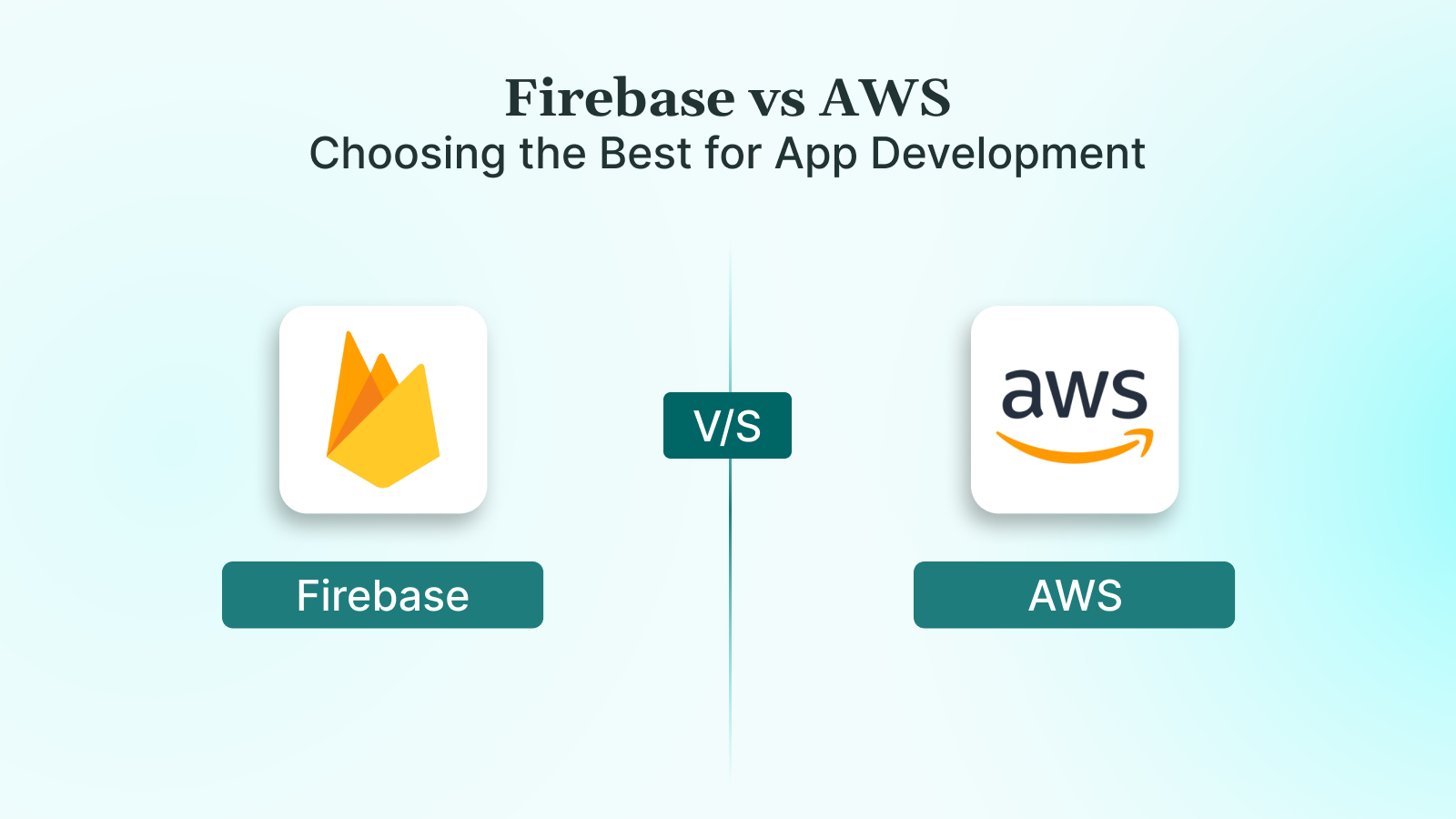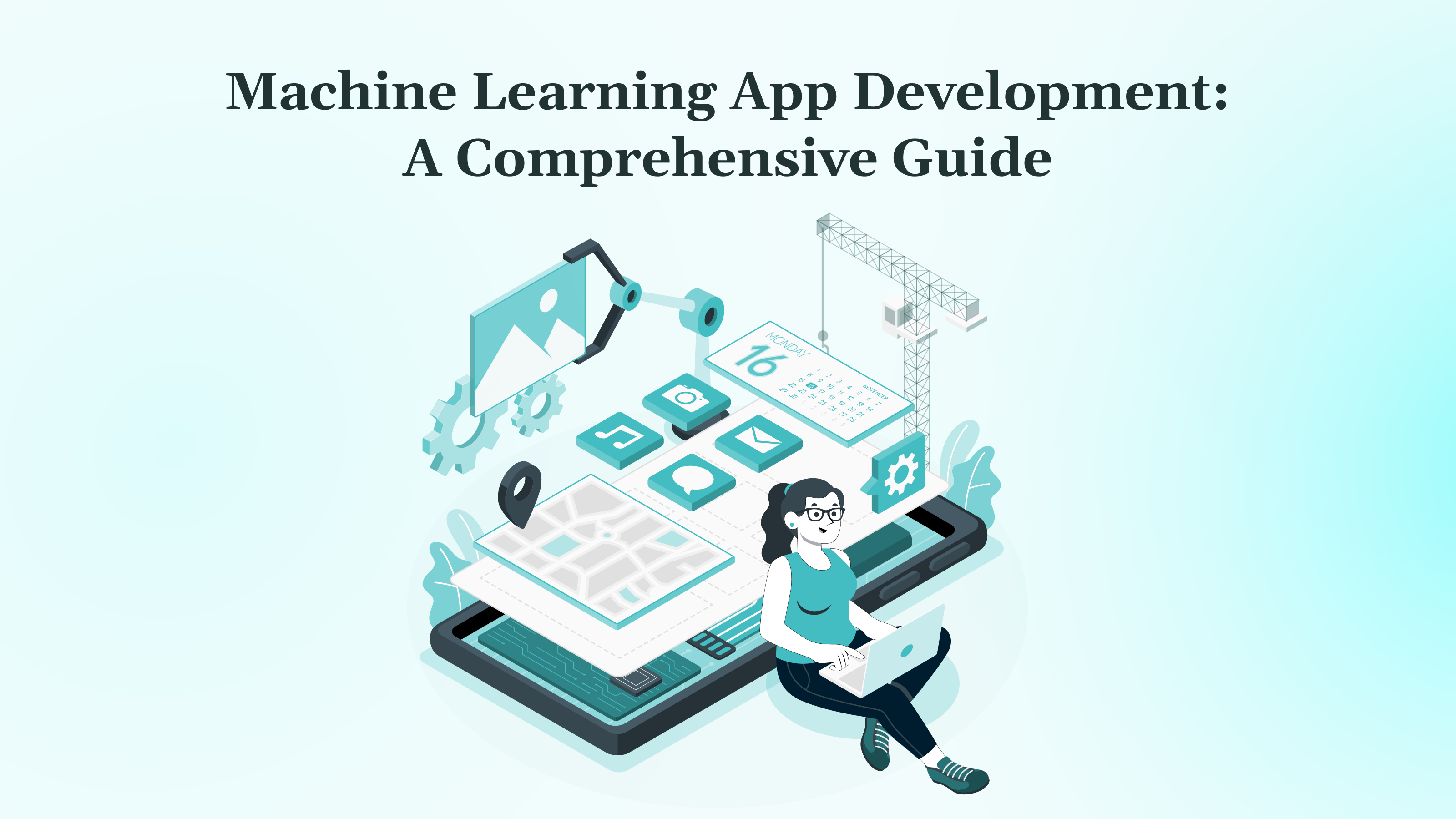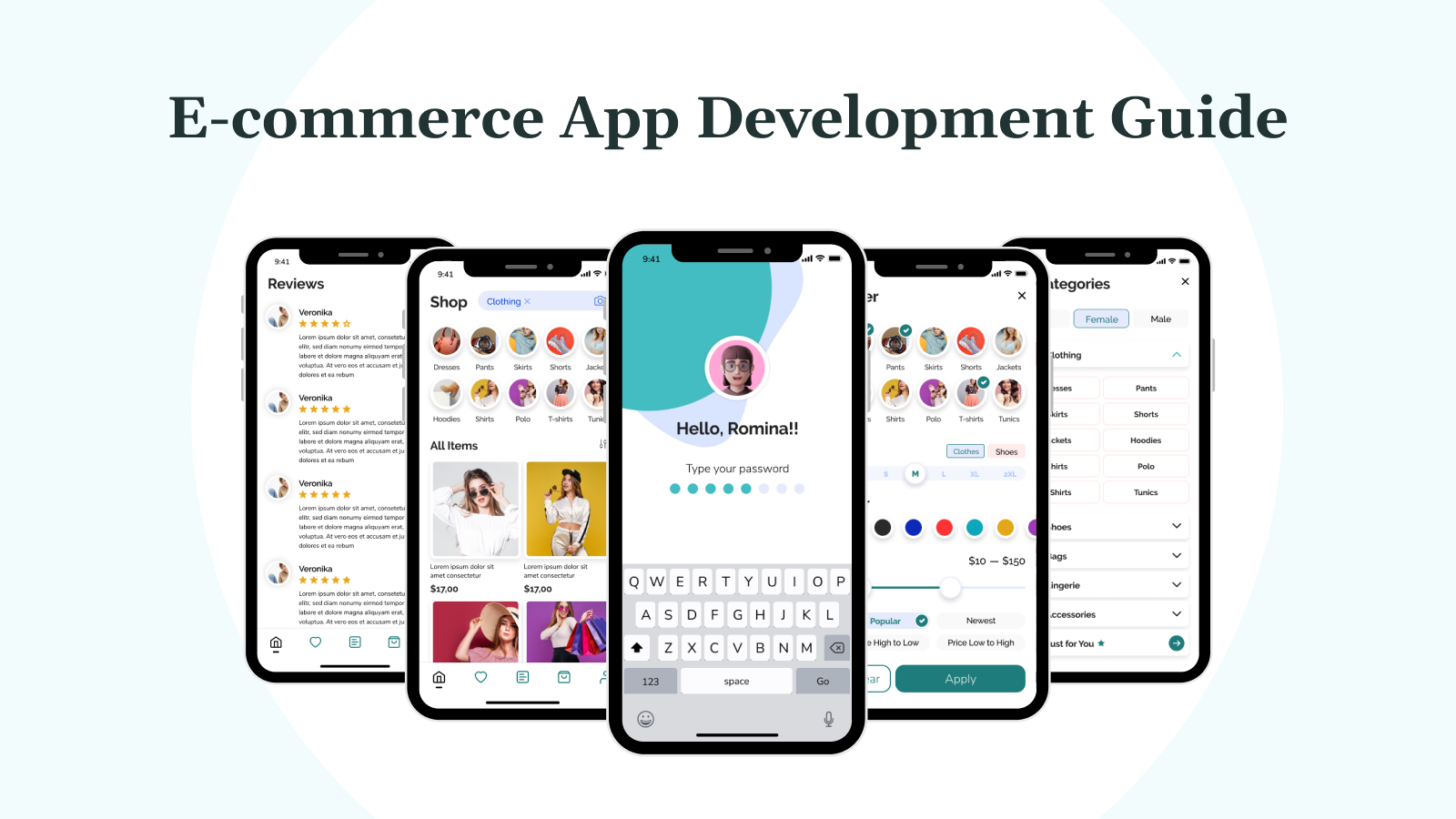Selecting a backend platform is one of the most strategic choices in software product development. For CTOs and product leaders in healthcare, fintech, logistics, edtech, and real estate, the right choice drives faster launches, seamless scaling, and robust security.
This importance is only growing. The global market for cloud services is projected to grow at a compound annual growth rate (CAGR) of 19.4% from 2024 to 2028, as organizations increasingly migrate their operations, data, and digital innovations to the cloud.
This guide compares Firebase and AWS, two core platforms enabling digital transformation in modern software.
Key Takeaways
- Firebase excels in rapid development, real-time apps, and MVPs, offering predictable costs and minimal DevOps requirements.
- AWS offers unmatched flexibility, enterprise-grade compliance, and massive scalability for complex, regulated, and large-scale applications.
- The right choice depends on project scope, industry compliance needs, team expertise, and long-term growth plans.
- Consider a hybrid approach to leverage Firebase’s speed for specific features and AWS’s power for core infrastructure.
- Strategic platform selection is crucial for faster launches, robust security, and seamless scaling in app development.
What Is a Backend Platform?
A backend platform delivers everything powering your app behind the scenes:
- Data storage and synchronization.
- User authentication and access control.
- Server-side computations and integrations.
- File, document, and media storage.
- Notifications and message delivery.
- Security, privacy, and compliance oversight.
- Analytics and monitoring.
The proper backend ensures your app is stable, secure, and ready for scale.
What Are Firebase and AWS?
Firebase is Google’s application development platform, designed to power mobile and web apps with integrated backend services. It offers Synchronized databases, authentication, analytics, and more, packaged for rapid deployment and high developer productivity.
AWS (Amazon Web Services) is Amazon’s comprehensive cloud computing ecosystem, trusted by startups and enterprises alike. From simple storage (S3) to advanced machine learning APIs, AWS supports nearly any conceivable app architecture across industries.
Why Backend Services Matter
Reliable backend services form the backbone of modern digital products. These platforms handle data storage, security, messaging, and user management. Strong infrastructure not only reduces the development burden but also ensures uptime and performance at scale.
- Safeguard sensitive health records.
- Secure transactions for fintech clients.
- Handle logistics tracking in real time.
- Scale education platforms for thousands of users.
- Automate tasks with AI where possible.
Purpose of This Comparison
This comparison is crafted for decision-makers facing crossroads. The wrong platform can derail deadlines, introduce security risks, or hinder future scalability. Understanding the trade-offs between Firebase and AWS enables informed choices that align with project scope, industry standards, and business growth trajectories. This foundation equips decision-makers to examine the features and benefits of Firebase and AWS.
Key Features and How Firebase and AWS Work
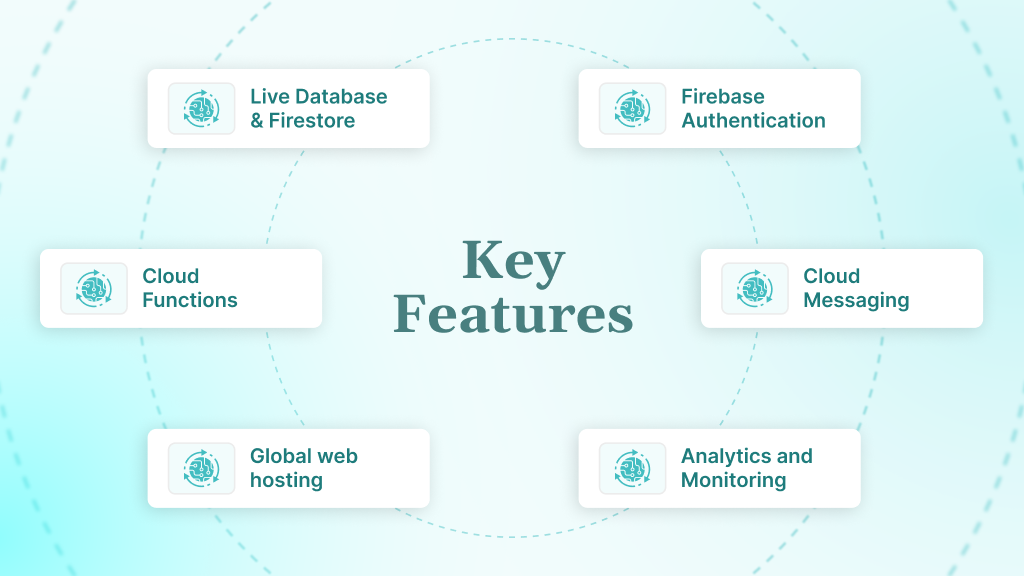
Firebase: Google’s Unified Cloud Backend
Firebase is designed as an integrated, developer-friendly platform that enables rapid app development and deployment. Its suite of tightly integrated services powers mobile-first applications with live collaboration features and minimal configuration:
- Live Database & Firestore: NoSQL databases delivering instant user data sync for collaboration, messaging, and dashboards.
- Firebase Authentication: Seamless and secure login with popular providers (Google, Facebook, email), including built-in multi-factor authentication and user management, which allows swift user onboarding without backend overhead.
- Cloud Functions: Serverless backend logic triggered by app events or HTTP requests, eliminating server maintenance for scalable event-driven workflows.
- Cloud Messaging: Integrated, customizable push notifications to engage users worldwide without managing custom servers.
- Hosting: Fast, secure, global web hosting with CDN and free SSL certificates, perfect for MVPs and early-stage projects needing zero-configuration deployment.
- Analytics and Monitoring: Usage tracking integrated with Google Analytics and Crashlytics provides actionable insights to inform product iteration.
This unified platform enables teams to focus on core user experience rather than infrastructure.
AWS: Flexible, Modular Cloud Ecosystem
AWS offers a comprehensive, customizable cloud ecosystem that caters to full-stack, enterprise-grade, and regulated applications, supporting diverse workloads and complex architectures:
- Amazon EC2 and Lambda: Host flexible virtual servers or run event-driven, serverless code globally, enabling fine-tuned compute resource management and microservice architectures.
- Amazon S3 and RDS: Industry-standard, secure object storage and managed relational databases (MySQL, PostgreSQL, Oracle, etc.) designed for mission-critical, large-scale datasets and transactional integrity.
- AWS Cognito: Advanced user identity management with single sign-on (SSO), multi-factor authentication, risk analysis, and granular access controls, meeting complex security and compliance needs.
- Analytics, IoT, and AI/ML Services: Powerful, enterprise-grade services for data processing, real-time analytics, machine learning integration, and IoT device management.
- Network, Compliance, and Security: Robust infrastructure guaranteeing high availability, fault tolerance, and compliance across HIPAA, PCI, GDPR, and SOC certifications.
AWS’s modular design allows teams to assemble tailored backend architectures optimized for their performance, compliance, and scaling requirements, making it the backbone of many global enterprises.
Comparison of Firebase vs AWS
This table condenses the key differences, helping decision-makers quickly identify which platform best matches their requirements.
| Feature | Firebase | AWS |
| Platform Type | Backend-as-a-Service, rapid setup | Infrastructure/Platform-as-a-Service, highly modular |
| Core Use Case | Startups, MVPs, mobile/web, real-time focus | Enterprises, regulated sectors, custom/large architectures |
| Database Options | NoSQL only (Firestore, Realtime Database) | Relational (RDS), NoSQL (DynamoDB, DocumentDB), warehousing (Redshift), more |
| Authentication | Simple, built-in (social/email/phone) | Cognito (multi-factor, SSO, advanced controls) |
| Hosting | Easy CDN-backed static/dynamic hosting, SSL | S3/CloudFront for static, EC2/Elastic Beanstalk for custom hosting |
| Serverless Functions | Cloud Functions (easy integration, moderate flexibility) | Lambda (multi-language, highly customizable, industry scale) |
| File Storage | Firebase Storage (Google Cloud backend) | S3 (industry gold standard, high reliability) |
| Analytics & Monitoring | Integrated analytics, Crashlytics, Google stack | Pinpoint, CloudWatch, deep custom monitoring |
| Compliance | Basic (limited for heavily regulated applications) | Enterprise compliance suite (HIPAA, PCI, GDPR, SOC2) |
| Scalability | Excellent for SMBs, mobile/web, real-time apps | Massive scale, global reach, complex systems |
| Customization | Limited, within the Firebase/GCP ecosystem | High total control over sthe tack and architecture |
| Pricing Model | Usage-based, clear free tier | Pay-as-you-go, granular, active monitoring needed |
| Typical Projects | Chat, MVPs, startup SaaS, real-time dashboards | Fintech, healthtech, IoT, logistics, enterprise platforms |
| Notable Users | Duolingo, Venmo, The Economist | Netflix, Airbnb, NASA, Samsung |
Firebase vs AWS: Pricing Breakdown
Pricing affects the long-term viability and flexibility of your app. The right choice keeps budgets healthy as products move from MVP to growth stage.
| Concept | Firebase | AWS |
| Free Tier | Generous storage, database, and authentication are free at a moderate scale. | Free tier available but spread across many services; deeper features usually not included. |
| Cost Predictability | High. Clear usage-based tiers, easy to forecast. | Variable. Pay-as-you-go with granular billing; requires active cost monitoring. |
| Cost at Scale | Costs can rise under heavy real-time data and traffic loads. | Flexible pricing with reserved options; optimized for enterprise scale. |
| Ideal For | Startups, MVPs, and early-stage products need speed and simplicity. | Enterprises with complex needs, regulatory compliance, and scaling requirements. |
Firebase offers predictability and low cost for early-stage growth and MVPs. AWS optimizes better at scale for established businesses, particularly those requiring regulatory or architectural flexibility.
Pros and Cons of Firebase and AWS
| Platform | Pros | Cons |
| Firebase | Rapid setup, integrated tools, real-time sync, predictable pricing, minimal DevOps. | Limited customization; NoSQL only; not ideal for strict compliance; costs at scale. |
| AWS | Full control, broad service portfolio, supports SQL and NoSQL, enterprise-grade compliance, and scale. | Steep learning curve, complex pricing, requires active monitoring, and a slower MVP launch. |
Use Cases by Industry

HealthTech
Firebase fits:
- MVPs, patient onboarding, live appointment reminders, and mental health check-ins.
- Teams needing fast rollout and real-time features, but not storing protected health information.
AWS fits:
- EHR/EMR, hospital management, telemedicine at scale, and regulatory-heavy data.
- HIPAA compliance, large teams, advanced reporting, and AI for diagnostics.
Example:
Precina: Enabled automation of medication reminders, seamless patient data integration, and HIPAA-compliant digital workflows while improving user experience and platform security.
FinTech
Firebase fits:
- Expense trackers, peer-to-peer payment prototypes, and onboarding mini-apps.
- Fast time-to-market and rapid validation.
AWS fits:
- Digital banking, trading apps, payment processors, full compliance, and robust audit trails.
- Multi-tenant, enterprise services, AI-driven finance.
DEVtrust in action:
Payvantage enabled instant device leasing approvals with real-time bank verification and automated payment processing for customers with no credit history.
Logistics & Supply Chain
Firebase fits:
- Live shipment tracking, fleet dashboards, and warehouse communication tools.
- Fast deployment, moderate traffic.
AWS fits:
- Multi-region routing, integration with fleet IoT, and real-time optimization at the global scale.
- Geofencing, predictive analytics, and compliance for logistics partners.
Example:
Draydex: Modernized rate management with instant pricing, real-time data tracking, integrated mapping, and secure payments, increasing transaction efficiency and user satisfaction for freight brokerage operations.
EdTech
Firebase fits:
- Quizzes, study tools, fast classroom app launches, and gamified engagement.
- Online learning startups, boot camps, and cohort-based courses.
AWS fits:
- AI-powered tutoring, adaptive LMS, analytics-heavy platforms.
- Compliance for student data, K–12, and multi-school deployments.
Example:
EdTech AI: Built an AI-powered school management platform that streamlines curriculum creation, enables real-time student progress tracking, and boosts classroom engagement with integrated communication and adaptive learning tools.
When to Use Firebase
- Fast validation cycles and prototype launches.
- Real-time data and event-driven experiences.
- Teams without deep cloud, DevOps, or security specialization.
- Tight budgets and short product cycles.
- Experiment-heavy or campaign/mobile apps with rapid iteration.
When to Use AWS
- Stringent compliance and data residency requirements (HIPAA, PCI, GDPR).
- Enterprise maturity, multi-region and cross-service integrations.
- Custom architecture, advanced networking, or computing requirements.
- Detailed cost controls and fine-grained scaling.
- Long-term growth plans with highly variable user traffic.
Understanding each platform’s strengths sets the stage for combined, hybrid architectures that blend speed and scale.
Hybrid Approach: Combining Firebase and AWS
Successful apps often combine Firebase’s rapid onboarding and live collaboration with AWS’s capabilities in data warehousing, analytics, AI, and regulated workflows. This hybrid approach delivers speed, flexibility, and enterprise strength.
Hybrid Integration Patterns: Making Firebase and AWS Work Together
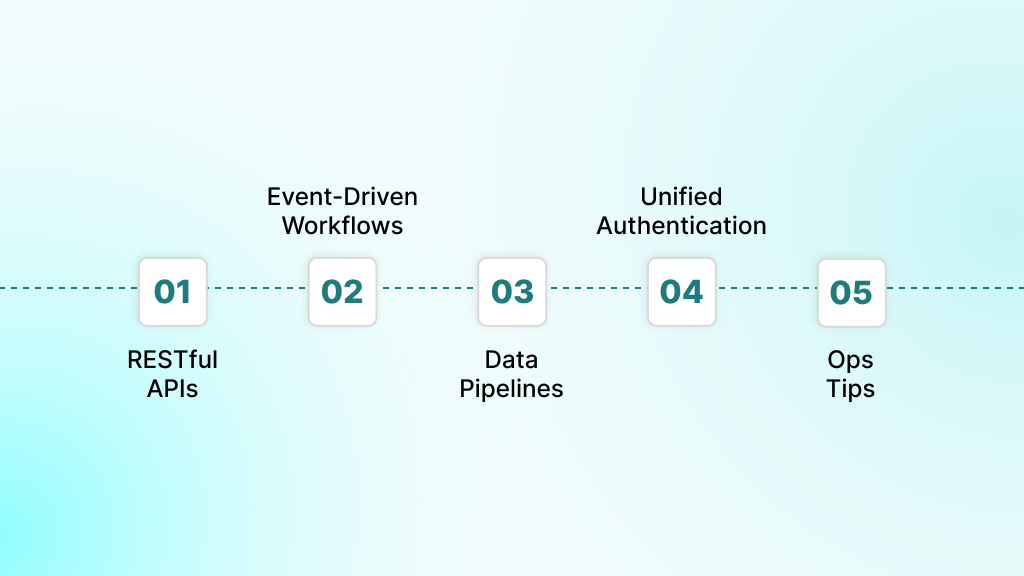
- RESTful APIs: Build secure REST APIs on AWS for frontends hosted on Firebase, with token-based user auth for secure data flow.
- Event-Driven Workflows: Trigger AWS Lambda from Firebase Cloud Functions or leverage pub/sub for cross-platform orchestration.
- Data Pipelines: Batch export Firebase data to AWS (Redshift, S3) for analytics and archiving.
- Unified Authentication: Bridge Firebase Auth with AWS service access using OIDC or JWT federation for seamless, secure identity management.
- Ops Tips: Utilize CI/CD pipelines for both platforms, monitor costs using both dashboards, and transfer only essential data to minimize latency/expense.
Three Questions for Technology Decision-Makers
- Does your solution require compliance with standards such as HIPAA, PCI, or SOC 2?
- Will you need real-time interactivity or just regular data synchronization?
- Is your team focused on rapid iteration and testing, or enterprise-level reliability and scalability?
The proper backend emerges from matching these answers to actual product needs and timelines.
How DEVtrust Delivers Backend Excellence
DEVtrust architects high-impact backend solutions for businesses that demand results:
- Strategic workshops to define backend needs, compliance, and market alignment.
- Custom development for health, finance, logistics, and education platforms.
- Real-time integrations (Stripe, Plaid, Twilio, OpenAI, Google Maps, AWS).
- Regulatory-ready infrastructure for any region or business scale.
- Hands-on support from design through deployment and ongoing evolution.
DEVtrust combines technical depth with a business focus, enabling teams to transform backend investments into a sustained advantage.
Future Prospects of Firebase and AWS
Firebase and AWS are improving with more AI features and better automation. These updates help apps grow faster and work better for many industries.
Potential Developments in Firebase
- Firebase is introducing more AI-driven features, enhanced integration, and expanded language support.
- Tools like Genkit and Data Connect make building and scaling modern apps easier and faster.
Future Directions for AWS
- AWS will strengthen industry-focused solutions with tighter compliance, more serverless services, and smarter automation.
- Its roadmap highlights better hybrid cloud options and expanded use of integrated AI.
Impact of Emerging Technologies
- Both platforms prioritize generative AI, automation, and low-code capabilities.
- These advances will accelerate app delivery and enhance flexibility for growing businesses.
Final Thoughts
The proper backend cannot be chosen from a feature list alone. Firebase and AWS both serve world-class platforms, but each is best suited to a specific phase and business model.
- Select Firebase for fast launches, MVPs, and rapid user engagement at a predictable cost.
- Select AWS for enterprise-scale, regulatory compliance, and systems that require control and flexibility.
- Combine both, as needed, to bridge the gap between speed and power.
Ready to accelerate your next digital project? Contact DEVtrust today to start building with confidence.
DEVtrust partners with teams to make backend strategy a business advantage. Do not let infrastructure bottlenecks define your success. Build on a foundation that grows with your ambition.
Ultimately, platform choice is not a checkbox. It drives delivery, user trust, and long-term growth.
Firebase vs AWS: Choosing the Best for App Development
Compare Firebase vs AWS for app development. Discover key features, pricing, and use cases. Choose the right backend service now!
Contact Us